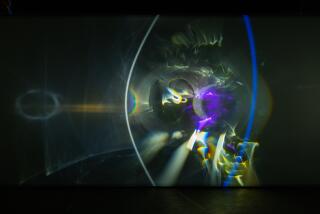‘Greek Miracle’: Small Show With Big Meaning : Art: Its 34 sculptures constitute the first exhibition of classical Greek sculpture from the fifth century BC ever to be shown in the U.S.
- Share via
WASHINGTON — As 2,500 years of art history wait in the wings, “The Kritios Boy” makes his move. Resting his weight on his left leg, he takes a small step forward, at the same time turning his thoughtful face ever so slightly to the right.
That is all, and in a physical sense it’s not much. But with that slight movement and that thoughtful look, sculpture steps out of the realm of the symbol and into that of the thinking human being, and art changes forever. If ever a gesture had far-reaching implications, this is it.
One of the things it symbolizes right now is the show it is in. For like this sculpture, “The Greek Miracle” at the National Gallery of Art is a small show with a big meaning.
Its 34 sculptures, quietly occupying a half-dozen spaces, constitute the first exhibition of classical Greek sculpture from the fifth century BC ever to be shown in the United States. They represent a seminal moment in the history of Western art. And they arrive on the 2,500th anniversary of the birth of democracy.
The development of the democratic city-state of Athens was not achieved in a day or a year, of course; it emerged in a series of steps. But a crucial one was taken in 508-507 BC, when the Greek statesman Kleisthenes reorganized the citizenry to reduce the power of the aristocracy and increase that of the citizenry as a whole.
What followed in the fifth century was the Golden Age of Athens, a unique flowering of culture. And it is a major point of this show--perhaps the major point--that the sculpture that comes here to celebrate the birth of democracy is more than merely a discrete manifestation of that flowering. It was precisely the Greek idea of the individual’s importance and responsibility that brought about the developments in art that we see in “The Greek Miracle.”
Philosopher Protagoras summed up the Greek attitude when he called man “the measure of all things.” Thus, “It was no coincidence that the Greek discovery of individual worth and freedom produced the most profound advances in art and sculpture,” writes Nicholas Gage in the exhibition’s catalogue. “If the spark of divinity is to be found in man, then the form and appearance of man would inevitably be the proper subject matter of the artist. The truth could be found in the natural world, including man’s body and mind, not in some mystical, incorporeal world.”
And that is precisely what we see in “The Greek Miracle”: a combination of growing naturalism in the depiction of the physical body together with the effort to represent a thoughtful and responsible consciousness guiding the body’s actions.
Appropriately, the exhibition begins with a point of departure, a late sixth-century statue of a youth, or kouros, that shows a considerable mastery of the representation of the body, but in a static pose and with the standard, slightly smiling expression characteristic of archaic sculpture. This is a man, but not an individual.
If one compares this statue with that of “The Kritios Boy” half a century later (480-470 BC), the change in the pose is not great. The weight is on one leg rather than both, the head is ever so slightly turned rather than staring forward. But the implications are enormous, for this figure has decided to move, and its expression is not blank but conscious and serious, as of one capable of making such a decision. “Critics have seen this figure,” writes J.J. Pollitt in another essay, “as perhaps the first sculptural image designed to express the new sense of individual responsibility (in democratic Athens).”
A little farther in the exhibition is one of a series of 12 metopes (about 460 BC) from the Temple of Zeus at Olympia. In this series, which depicts the labors of Heracles, the hero actually ages, until in the show’s example he is shown fully mature and with a beard.
If there is a growing naturalism in fifth-century sculpture, however, the exhibition also makes clear that there is as well an idealization of form that reflects the ideal of what the good citizen should be: thoughtful, responsible and moderate in all things. “The blending of pragmatism and idealism that characterized Periklean political policy was also a feature of the major lines of philosophical thought and of the aesthetic sensitivities of the age,” writes Pollitt.
This combination of qualities comes together, he points out, in the Parthenon frieze (442-438 BC), of which a section is included in the show. Rather than the usual temple decoration--feats of gods, goddesses and heroes of myth--the frieze depicts ordinary people in a contemporary event: cavalry in the Panathenaiac festival. Their poses could not be more naturally graceful, but at the same time, Pollitt notes, “the simplified geometry, unruffled serenity, and all-pervading youthfulness of human forms create the atmosphere of a timeless, quasi-divine world.”
One of the most indelible impressions the exhibition leaves is the fact that art does not live in a vacuum--it reflects the society in which it is created. If there are aspects of our own art that we find less than ideal, the fault may lie not so much in our artists as in ourselves.
More to Read
The biggest entertainment stories
Get our big stories about Hollywood, film, television, music, arts, culture and more right in your inbox as soon as they publish.
You may occasionally receive promotional content from the Los Angeles Times.










